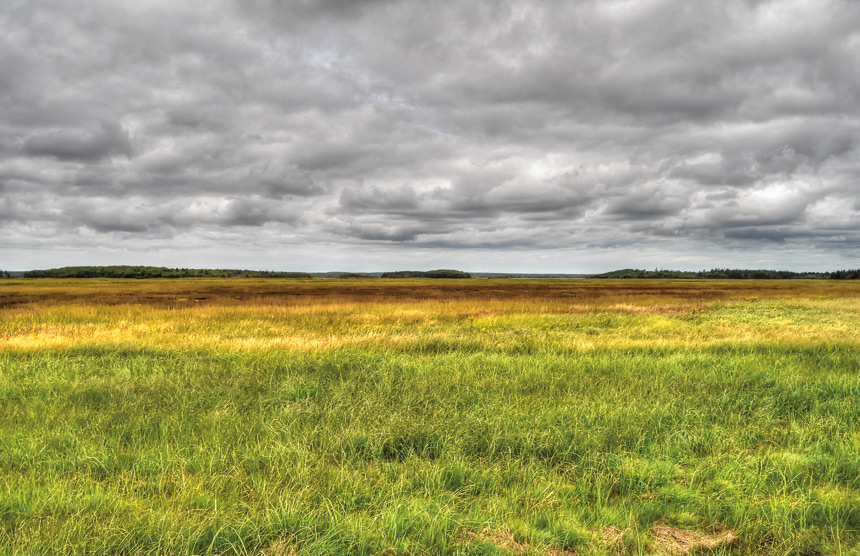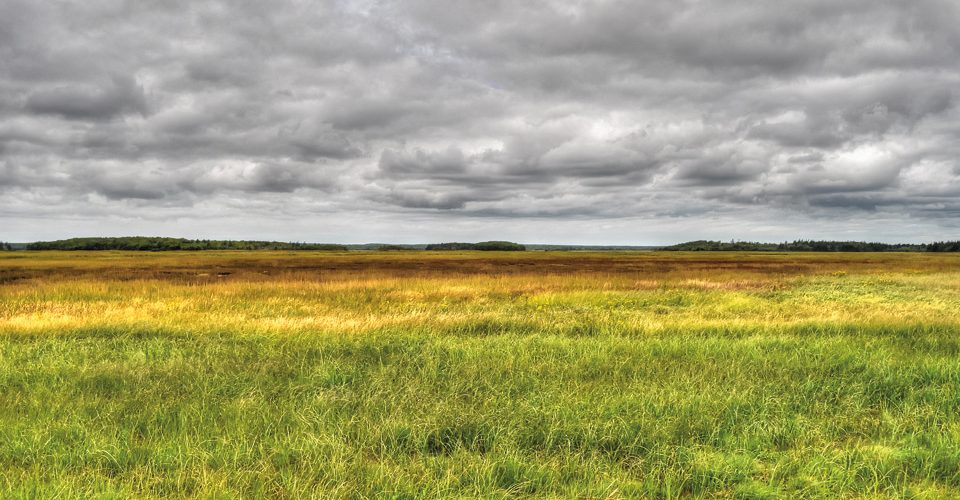
Photo gallery: salt marshes in Atlantic Canada – click to open

Photo gallery: salt marshes in Atlantic Canada – click to open
Tantramar Marsh. Photos by Lisa Szabo-Jones
Salt marshes are “a place between the tides,” as described by Nova Scotia poet Harry Thurston. They are made of both land and water, not just wet land – ecosystems dominated by grasses and flooded repeatedly by saltwater tidal flows. They shore up the edge tensions between water and land, and offer much reflection on the settling and unsettling convergences of natural and human histories. Ecotones are transitional areas of vegetation between two different ecosystems, where boundaries shift and habitats blend into one another; and as they are terrestrial systems overlapping with oceanic systems, they are examples of the mingling of local and global ecosystems.
To think of salt marshes involves consideration of how coastal wetland ecological processes developed over millennia – establishing relationships through seasonal flux – and how quickly human actions are able to disrupt and destroy these evolved systems. Salt marshes are one of Earth’s great global ecosystems, comprising approximately 49 million hectares worldwide. Because of the interaction between tides, rivers, and natural or human tidal barriers, salt marshes are in a constant process of burying and sweeping out sediment. These processes are further affected by sea level and climate changes. The marsh forms when the deposition and erosion of sediment reach equilibrium, soil builds up, and saline-tolerant vegetation takes hold and flourishes.
Salt marshes are typically delineated by tidal range and the dominance of saline-tolerant plants such as the different types of cordgrasses. In the Bay of Fundy of Nova Scotia and New Brunswick, smooth cordgrass (Spartina alterniflora), with its capacity to tolerate regular twice-daily submersion, dominates the low marsh. In the high marsh, which experiences intermittent flooding, saltmeadow hay (S. patens) thrives, along with a handful of other low-lying plants. These sites then become nesting and staging areas for migrating birds such as willets and other shorebirds, and nurseries for fish, molluscs and crabs.
As one of nature’s rare natural monocultures, these maritime “prairies” of cordgrass (Spartina spp.) grow as high as two metres in the summer. In the winter, ice-rafting shears the stalks to stubble or flattened, tangled mats. It may be this monocultural characteristic that causes humans to devalue the ecological and aesthetic worth of coastal wetlands. The grasses stretching for hectares seem uniform in their seasonal coats of green or brown. As with the perceived “emptiness” of tundra or prairie grasslands, many see these coastal ecosystems as barren wastelands. The smell of decay adds further to this perception. Many do not think about the smaller life forms that inhabit these ecosystems and their integral part in the healthy functioning of global systems. Nuances remain hidden from distanced viewpoints.
Combined, the grasses and the built-up islands of sediment and trenches mitigate flooding and coastal and inland erosion by reducing the impact of tidal and storm-surge energy. They also act as water purifiers and important sites of primary production – the generation of plant biomass, much of which is exported to oceanic water where it becomes part of the marine food web.
In Atlantic Canada, salt marshes facilitate a high exchange productivity of nutrients. Cordgrass maintains ongoing photosynthetic activity, and the rapid rate of decomposition introduces essential nutrients into the marine food system. Relatively undisturbed by human impact prior to European settlement, many of the Bay of Fundy’s salt marshes, over long lengths of time, developed rich, deep soil. For thousands of years, they also provided sustenance for the Mi’kmaq. In the 17th century, Acadian settlers, in agreement with the Mi’kmaq, dyked much of Fundy’s coastal wetlands, turning marsh into farmlands. Following centuries of human reclamation projects, the construction of tidal barriers (culverts, causeways and dams) helped reduce the salt marsh area by 80 per cent and diminished much of the marshes’ contribution to the marine food chain.
If disturbed, salt marshes hold the potential to emit significant quantities of greenhouse gas.
Recent studies bring to light another aspect of salt marshes – which may, in the growing movement for climate action, initiate greater conservationist practices. Salt marshes are carbon sinks that have accumulated vast stores of carbon over centuries. The flip side is that, if disturbed, they hold the potential to emit significant quantities of greenhouse gas. Drainage, in particular, releases the stored carbon into the atmosphere and reduces the marsh’s ability to sequester more carbon. For some, “blue carbon” offers the hope of preserving salt marshes by communicating value through the language of economics. But how do we relate the value of salt marshes as carbon sinks, and achieve a similar appeal to restoration and conservation in non-economic terms?
Many different approaches have evolved to return the coastal wetlands to the tides – and imaginations – of Atlantic Canada. Through conveying the beauty of wetlands, painting and poetry have drawn pathways between hearts, minds and marsh. Alex Colville, Anne Simpson, G.D. Roberts, Bliss Carmen, Harry Thurston, Douglas Lochead, John Thompson, Ron Hayes, Basma Kavanagh, Thaddeus Holownia and John Frederic Herbin are just a few who have found inspiration in the salt marshes.
But science and industry must also play a role. A joint venture between the Irving family, Ducks Unlimited, and Acadia University monitors and manages the breach of the dykes at the foot of Fort Beauséjour. Across the bay, in the Southern Bight, a collective of working groups in partnership with St. Mary’s University and local communities have conducted audits of the bay’s tidal barriers and initiated restoration projects. In Cheverie, the Nova Scotia government and the Ecology Action Centre partnered with the Cheverie Crossway Saltmarsh Society to replace a restrictive culvert under Highway 215 and open Cheverie Creek to wider flows of tidal water. The project included, but also took an unusual turn from, traditional restoration designs aimed at attracting and educating visitors. Not only did they construct boardwalks through the marsh and build an interpretive centre, but Dalhousie University professor Ted Cavanaugh and his Coastal Design architectural students partnered with the project and designed and built a fully functioning brick shell camera obscura that overlooks the Bay of Fundy and the marsh.
Yet, the best stories are always the unexpected ones. On my last day in Nova Scotia, Mike Brylinsky, senior research scientist from Acadia University, took me out to the Avon River estuary and to Windsor, NS – the town that holds claim to the birthplace of hockey. In the 1960s, the town built a causeway, effectively blocking the inflow of ocean tides into the river. But shortly after the causeway’s completion, the estuary’s enclosed geography and the redirected tidal currents created the necessary conditions for land to form and vegetation to take hold. A marsh started to grow, and continues to grow. Today, Windsor Marsh is one of the most productive salt marshes in the North Atlantic. The town celebrates this wonder with a dedicated website and a marsh webcam. Windsor Marsh, though, is not proof that nature can bounce back after major human disturbance. In this instance, all the conditions were in place for a marsh to grow.
I found myself many times ass- or face-planted in mud and tall grass, chased by a skunk, tripped by concealed roots and swarmed by mosquitoes.
Salt marshes remain notoriously inaccessible habitats. We cannot hike them as we do mountains or deserts. In my attempts to wander out onto the marshes of Nova Scotia and New Brunswick, I found myself many times ass- or face-planted in mud and tall grass, chased by a skunk, tripped by concealed roots and swarmed by mosquitoes. I misjudged ‘solid’ ground and sunk to my knees. I miscalculated embankments and belly flopped in mud. Deep trenches, mud patches, tidal pools and a fear of sinkholes prevented me from venturing far out into the marsh. How could I get up close and see the beauty – the diverse range of colours of the grasses, open my ears to the scratch of fiddler crabs, the sloosh of mummichog, small killifish, in tidal pools? It took a willingness to lose a rubber boot, spend a day with a soaker, acceptance of dirty, damp knees and scratched and bitten flesh. At certain times of the year such commitment to explore the marsh goes a long way. But, standing on the edge, mindful of where we step, this too is a form of commitment that can go far in letting these systems flourish.
Lisa Szabo-Jones is co-editor of The Goose, a journal of arts, environment and culture in Canada.













